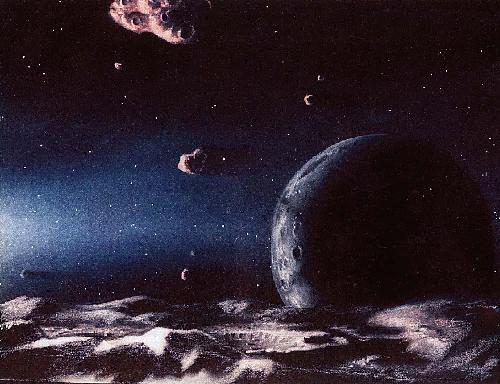 NASA Cassini image of Phoebe showing cratered
surface. Click for larger view.
NASA Cassini image of Phoebe showing cratered
surface. Click for larger view.
| IS PHOEBE A KUIPER BELT OBJECT? |
|---|
Phoebe
Phoebe is a 200 km scale irregular satellite of Saturn. With a retrograde
orbit (inclination 178 deg), Phoebe cannot have formed in a Saturn-associated
accretion disk and, instead, is inferred to have been captured from
an independent orbit around the Sun.
 NASA Cassini image of Phoebe showing cratered
surface. Click for larger view.
NASA Cassini image of Phoebe showing cratered
surface. Click for larger view.
Phoebe was first imaged close-up by the Cassini spacecraft in June 2004. Almost immediately, press reports and some scientists began to claim that Phoebe is a captured Kuiper Belt Object.
From Where Was Phoebe Captured?
The two main possibilities are that
1) Phoebe was captured from heliocentric orbit near Saturn, probably in association with planet formation itself. If so, it grew as one of many objects in the disk some of which accumulated to build Saturn's core, others of which were ejected to the Oort Cloud and interstellar medium, and very few of which were captured as irregular satellites.
OR
2) Phoebe was captured from a more distant reservoir, possibly the Kuiper Belt. We do not possess any way to decide clearly between these possibilities. Recently, Kuiper Belt capture has been widely publicised and two (not wholly convincing) strands of evidence have been supplied.
First, Johnson and Lunine (2005, Nature, 435, 69-71) argue that the 1.6g/cm3 density of Phoebe is closer to the 1.9g/cm3 of Pluto than to the 1.3 g/cm3 density of Saturn's regular satellites and that Phoebe must therefore be a captured KBO. However, there is no clear connection between density and formation location, so that Johnson and Lunine's conclusion that Phoebe must be captured from the Kuiper Belt, as opposed to locally, cannot be justified on this basis. In fact, the densities of Kuiper Belt Objects are widely dispersed, from about 0.5 to 2.5 g/cm3. Again, this does not point cleanly to a Kuiper belt origin for Phoebe. Their conclusion is also questionable when one looks at the measured densities of the Saturnian regular satellites, for example at the JPL site. For example, Enceladus (1.6 g/cm3) is similar to Phoebe and Dione (1.5 g/cm3) is nearly as dense. Are these from the Kuiper Belt too?
Second, Clark et al (2005, Nature 435, 66-70) argue that the wide variety of ices discovered spectroscopically on Phoebe is more consistent with an origin in a cold place, perhaps in the Kuiper Belt. This claim seems more solid, although Clark et al correctly note that a coating of ices delivered by comet impacts could account for their data.
Dynamically, capture from nearby orbits is easier, since the capture cross-section decreases as the relative velocity of encounter increases and in-coming KBOs would be travelling faster than nearly co-orbital precursors. Morbidelli et al (2005, Nature 435, 462) have found a way to capture Kuiper Belt Objects long after planet formation, albeit with an extremely low efficiency. They rely on planetary migration and a sequence of events that may not have occurred in the real Solar System.
So, what is it?
EITHER: Phoebe is an ice/rock planetoid captured from a near-Saturn
orbit at the end of Saturn's growth.
OR: Phoebe is a captured KBO.
We don't know.
Wherever it came from, Phoebe is still interesting, of course. Like all the irregular satellites, it provides a relatively direct link to an earlier epoch when, unlike now, permanent capture was possible.
David Jewitt.
Russian translation by Vlad Brown.
 |
 |
||
| Comet | Jewitt | Kuiper | Irregular Satellites |
|---|